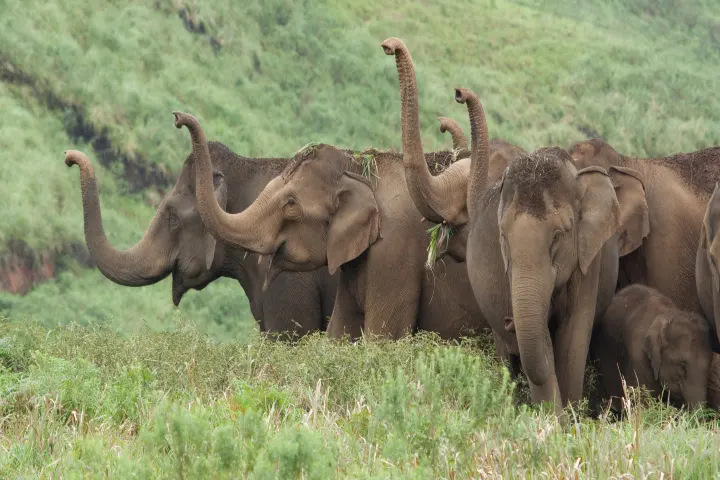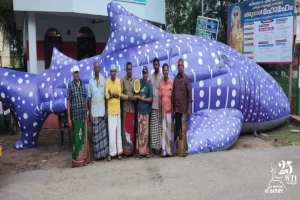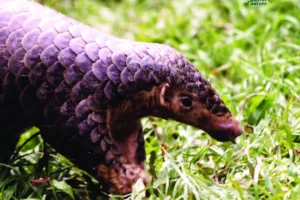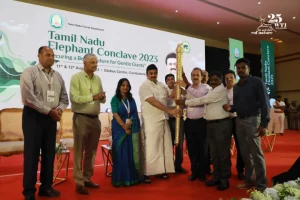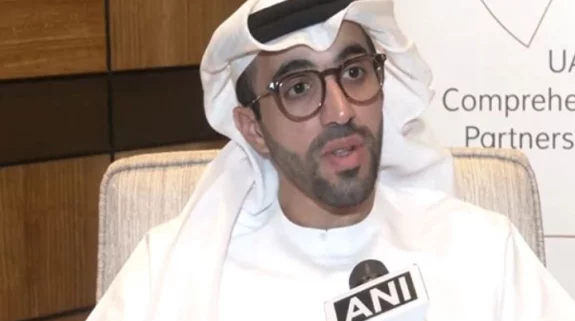The Forest Department of Karnataka in collaboration with Wildlife Trust of India last week launched the Hostile Activity Watch Kernel (HAWK) system. It is a special software for wildlife crime management which is being supported by Nippon Telegraph and Telephone Public Corporation (NTT DATA), a leader in information technology services.
In an interaction with India Narrative, Jose Louies, Director and Chief of Wildlife Crime Control, WTI talked about how the HAWK came into being, the challenges in developing it and how it will be effective in curbing and preempting wildlife crimes.
Excerpts from the interaction:
Q) What is the genesis for creating the Hostile Activity Watch Kernel system and how was it developed?
A) HAWK, a specialized software system is the result of a response to widespread elephant poaching incidents that took place in Kerala in 2015-2016. About 35 elephants were killed during this period. It was the case of major poaching in South India and took place in Kerala and Tamil Nadu and was connected to Karnataka also.
As part of investigation into this incident, the Wildlife Trust of India as a technical agency observed that poaching gangs operated across the States and boundaries and that there was no prior information about them even though most of them were history sheeters. It was found that there was a recurrence of the same crime by the same people but there was a lack of a centralized system which could collate and put together data about them in a proper form and format. For instance, it was not possible to know the number of elephant poaching incidents a certain person say X was involved in and the number of animals he had killed and the areas he operated in. Essentially it indicated the lack of centralized intel management and monitoring across the State. None of the States have centralized wildlife crime management systems for their respective forest departments. The data is in paper files and they don’t have any active intel value.
As Kerala was the most affected States in the poaching incidents spanning from 2015 to 2016, they started the groundwork for HAWK – which is a Cloud based information management system — in 2017 headed by Dr. Amit Mallick, an Indian Forest Service officer.
Based on interactions with personnel of intelligence agencies it was realized that there was a need for a system to gather intel, data, and information that should be simple and user-friendly for the frontline staff. WTI took the responsibility of developing the system. Mr. Manu Sathyan, an officer from the Kerala Forest Department coordinated the entire work for the department.
Constant consulting with frontline staff and their seniors enabled us to realise their practical problems. For instance, we found that there should be no repetition of data. If the name of a certain person has been entered, the next time it is typed in the system to make subsequent entries, the user should be informed about it and information should be automatically accessible. The system had to be fool proof to ensure that all the procedures are completed and captured in a linear way to pave the way for preparing proper documentation by the system.
Finally, the system had to be simple like a Facebook or Whats app. It had to be scalable and required the provision of implementation first at range level, then division and then ultimately at the State-level.
From 2017 to 2019 HAWK was developed for Kerala and it was implemented in 2020 at the Periyar Tiger Reserve. Based on its performance, it was implemented in the State and by 2020 the HAWK had fully taken over the paper-based system.
Q) Tell us about HAWK implementation in Karnataka where it was launched recently at Nagarhole Tiger Reserve with commencement of training in Antharasanthe Range.
A) The Karnataka Government came forward to use the HAWK when they realized how useful it is. The IT team of their Forest Department took upon itself to build a hybrid system and make the State machinery a part of the whole process of digitization of wildlife and forest crimes.
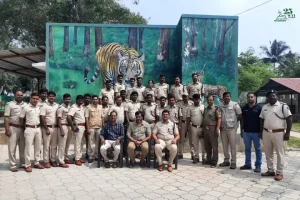
The Kerala implementation had provided a lot of input about the practical aspects of the system like font, colour, connectivity issues among others. HAWK is still under development and will be completely ready in six months and till now data of more than 35,000 cases have been uploaded.
It is a customized software and will include a lot of analysis modules; all information starting from filing an FIR online; details of investigation and approvals. The system will be integrated with the judicial system.
While allowing monitoring the status of cases, it will also help in ascertaining causes for delay in investigation. It will help in the creation of an exhaustive database of legacy crimes and criminals. The Karnataka Forest department will operate and maintain the system. This will ensure that the department is a part of the system’s development process and is self-reliant in maintaining it.
More than 300 forest officers have been trained online and in 2023, the department has planned to train 500 more officials. Every forest range will have at least five trained staff members. Apart from this a technical team is in place to provide real-time assistance to the new users.
Once the Karnataka system is in place, it will be connected to the Kerala HAWK enabling access to information on a need-to-know basis. For example, it can be found out if a certain suspect or suspicious vehicle has been involved in another State in other crimes.
In fact, the efficacy of the system came to the fore in 2020 when an officer in Mysuru arrested Pristine D’Silva from a hotel room where an ivory deal was being negotiated. D’Silva denied involvement, stating that he had gone there to meet someone. There was no case history available against him in Karnataka. Karnataka contacted a forest officer in Kerala to know about D’Silva. The official searched the HAWK platform and found several cases pending against him. This information played a crucial role during the hearing of D’Silva’s bail plea in a Karnataka court.
Q) Please elaborate on the benefits HAWK will provide to the wildlife officials at different levels in combating and curbing crimes.
A) HAWK will play the role of the nerve centre of the State’s Forest Department as part of their modernization initiatives. The system’s dashboard will have all the information related to forest and wildlife crime for each level officers with access level controls. The Chief Wildlife Warden will have all the information and data across the State and his juniors get access to their respective areas.
It will reduce time considerably in preparing cases against offenders, bring in transparency and also make the overall process more efficient. Officers can use the central database to search for habitual offenders, case references, suspected criminal activities, movement of suspicious vehicles, death of wildlife etc.
Q) Share with us features of the HAWK and its multiple modules.
A) The HAWK has four different modules covering wildlife death; documentation of wildlife and forest crime; suspect database that includes details about vehicles, weapons and persons involved in wildlife crimes; and a mobile app which can be accessed and used by frontline staff to allow them to connect with server in real time and get immediate information. If a forest department personnel in deep forest sights a suspicious vehicle they can login and find out if there are any prior details on it.
A distinctive feature of HAWK is its overall architecture which allows more modules to be added, depending on the need, requirement, bandwidth and resources of the users, namely the State. The whole aim is to initiate on a small scale and then allow the system to grow organically while ensuring its acceptance by frontline staff.
Q) Apart from helping forest department personnel get real-time information, how will analysis of the data help in fighting and preempting wildlife crime?
A) Information, data, and intelligence are all connected. Once we have the data, analysis is possible to obtain connections, interlinks, trends about seasonality of crimes, particular modus of operation and regions. It will help in finding connections between timber felling and elephant poaching or killing of animals and human-animal conflict. The system will provide maps and visual data also.
All this will definitely aid in preempting and reducing wildlife crimes besides providing inputs on how to deploy staff according to a particular season and region. Once enough data is entered into the system, analysts can do deep analysis of the information to find patterns. These crime enabling patterns then can be effectively used to prevent offenses.
The data about wildlife deaths, criminal activities and movement of suspicious vehicles and other incidents in the centralized system can be effective in providing pre-emptive responses including initiating counteraction.
The system can also create a feel of “being monitored” to habitual offenders which will be a good disabler as it will constantly keep the forest officials updated about the movement and activities of the concerned offender.
With Kerala and Karnataka going in for HAWK, it will hopefully become a pan-India system making conservation of forests and wildlife more efficient.
Q) What safeguards are in place to ensure that the system is not misused?
A) This was one of the important concerns when the system was being developed. It has in place a logging tracking device through which who logged when and entered or changed what data can be traced. Also, once the First Information Report is lodged it is locked and no editing is possible. We have in place a strict hierarchical system whereby editing is only possible after prior permission. Thus, monitoring of data and its alteration is done at multiple levels.
Data will be on the Government server and information on it will be government property. There are several security standards in place and these are audited from time to time. In Kerala a security audit is going on at present.
Q) Use of technology and artificial intelligence can go a long way to preserve the environment and wildlife. Your comments.
A) Tech is the key tool and people should use them, upgrade them regularly to make use of the same. There is a need to have a longer vision to design, develop and implement a system. Other countries have adopted technology to prevent and fight poaching. In East Africa a information system which uses GPS to enter information on animal deaths, poaching, and human-wildlife conflict is in place. Likewise, rangers in Kenya track threats to elephants through an app-based system.
Also Read: Forest officials trace 3 cubs of tigress that died in Karnataka’s Nagarhole reserve






